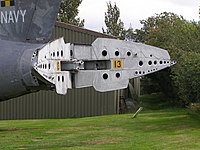Air brake (aircraft)

In aeronautics air brakes are a type of flight control used on aircraft to reduce speed during landing.
Air brakes differ from spoilers in that air brakes are designed to increase drag while making little change to lift, spoilers greatly reduce lift while making little change to drag.
Often, both characteristics are desirable and are combined - most modern airliner jets feature combined spoiler and airbrake controls. On landing, the deployment of these spoilers causes a dramatic loss of lift and hence the weight of the aircraft is transferred from the wings to the undercarriage, allowing the wheels to be mechanically braked with much less chance of skidding. In addition, the form drag created by the spoilers directly assists the braking effect. Reverse thrust is also used to help slow the aircraft after landing.
One interesting airbrake design is the deceleron, a special kind of aileron that functions normally in flight but can split in half such that the top half goes up as the bottom half goes down to brake. This technique was first used on the F-89 Scorpion and has since been used by Northrop on several aircraft, including the B-2 Spirit.
The British Blackburn Buccaneer naval strike aircraft designed in the 1950s had a tail cone that was split and could be hydraulically opened to the sides to act as a variable air brake. It also helped reduced the length of the aircraft in the confined space on an aircraft carrier.
